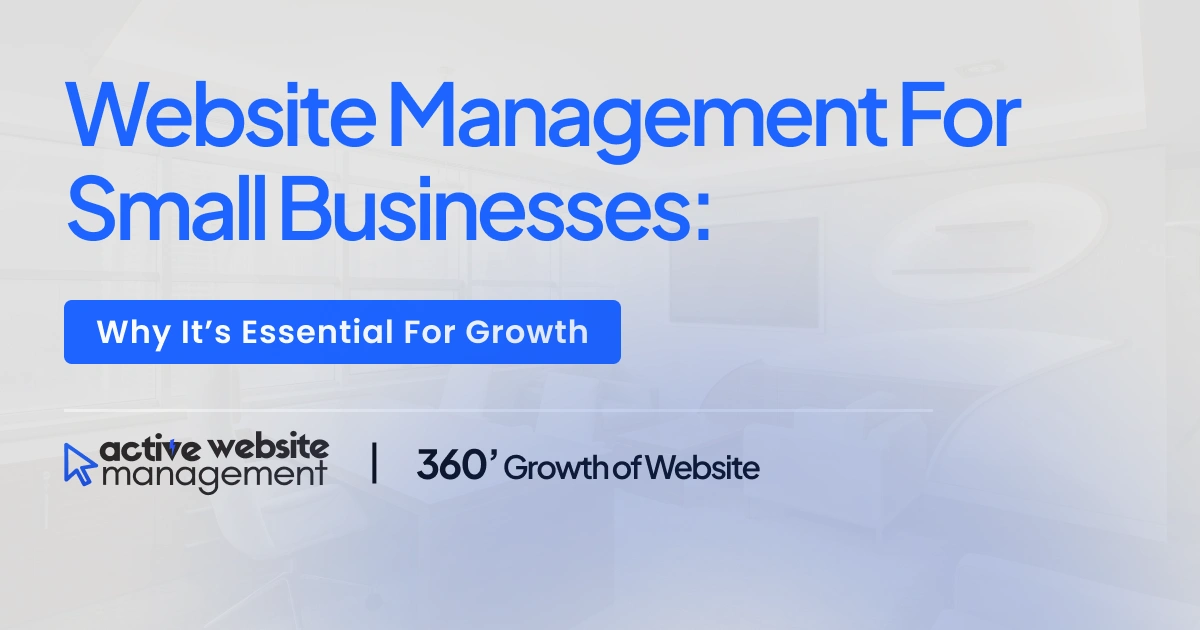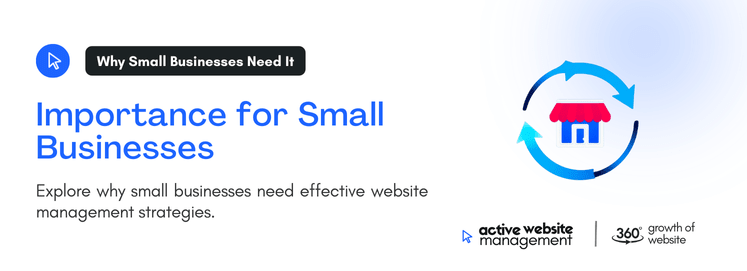
In today’s digital landscape, your website is the face of your business. For small businesses, the website often serves as the primary touchpoint between the brand and potential customers. But having a website is not enough—what really matters is how well it’s managed. Website management involves consistent updates, performance monitoring, security enhancements, and strategic changes to ensure your site is always performing at its best.
For small businesses, managing a website might seem like an overwhelming task. However, it’s an investment that directly impacts your growth, visibility, and customer trust. In this article, we’ll explore what website management entails, why it’s critical for small businesses, and how it can help your business thrive online.

Website management is a holistic approach to ensuring that a website functions properly and meets the goals of the business. It involves a range of tasks, including:
In short, website management is the continuous improvement of your website to meet evolving user expectations and business needs.

Small businesses often overlook website management due to limited resources or a belief that once the site is live, the job is done. But in reality, website management is an ongoing process that can yield significant benefits.
In the fast-paced online world, competitors are always just a click away. If your website is outdated, slow, or difficult to navigate, potential customers will quickly leave and move on to a competitor with a better online presence.
Don't Wait for Growth—Accelerate It with Active Website Management
For small businesses, establishing credibility is one of the most important factors in driving success. An actively managed website helps build trust with your audience by showing them that you’re serious about your online presence.
Learn more about The Impact of Website Design on User Trust and Engagement

A well-managed website puts the user first, ensuring easy navigation, quick load times, and mobile-friendliness. This is especially important for small businesses trying to make a great first impression.
Small businesses can’t afford to overlook SEO. It’s one of the most cost-effective ways to increase visibility online. SEO is not just about keywords—your website’s overall health plays a huge role in your rankings.
Small businesses depend on lead generation to grow. A website that’s regularly managed can serve as a powerful lead generation tool.
Your business goals will evolve over time, and so should your website. With website management, you can quickly adjust to changes in the market or within your industry.
While many small businesses understand the importance of website management, finding the time and expertise to do it effectively can be a challenge. That’s where Active Website Management comes in—a service specifically designed to handle all aspects of your website’s growth and maintenance.
Active Website Management ensures your website is consistently updated with fresh content, improved performance, and enhanced security measures. This keeps your site relevant and high-performing, even as your business grows.
Active Website Management focuses on improving your site’s SEO by optimizing content, enhancing load times, and making technical improvements. This means your business will be more visible in search results, driving more traffic and leads.
Don't Wait for Growth—Accelerate It with Active Website Management
One of the benefits of Active Website Management is that it’s tailored to your specific business needs. The service starts with a detailed analysis of your goals and then creates a monthly plan to ensure those goals are met.
Perhaps the greatest advantage is that Active Website Management takes the burden off your shoulders. Rather than worrying about technical issues, content updates, or performance problems, you can focus on running your business while experts manage your website.
If you’re managing your website in-house, here are some common tasks you should regularly complete:
Make sure to back up your website data regularly. This protects you from losing valuable information in case of a technical issue or hack.
Tracking how users interact with your website through tools like Google Analytics gives you insights into where improvements are needed.
Outdated software is a common target for hackers. Regularly update your content management system (CMS), plugins, and other software to keep your site secure.
Over time, some links on your website may become outdated or broken. Regularly testing for and fixing broken links improves your site’s user experience and SEO.
Website management is the process of regularly updating and optimizing a website to ensure it functions smoothly, remains secure, and aligns with business goals. For small businesses, this is essential because a well-managed website helps attract more customers, build credibility, and ultimately drive growth.
Typical website management tasks include content updates, SEO enhancements, performance monitoring, security updates, and user experience improvements. These activities ensure your website is current, engaging, and protected from online threats.
Regularly updating your content is key to staying relevant. We recommend refreshing your website’s content at least once a month to keep your audience engaged and improve SEO rankings.
A good user experience (UX) is vital for keeping visitors on your site. Websites with intuitive navigation, fast load times, and mobile-friendly designs reduce bounce rates and encourage visitors to stay longer, leading to more conversions and repeat customers.
Yes, managing your website includes performance optimization, which directly impacts load speed. Tasks like compressing images, enabling caching, and minimizing code can improve speed, keeping users engaged and positively impacting SEO.
Active Website Management ensures continuous SEO improvements by focusing on technical aspects (like mobile optimization and security) and content optimization. This ongoing approach helps maintain and improve search engine rankings, attracting more organic traffic.
If you notice slow load times, outdated design, broken links, low search rankings, or a decline in visitor engagement, these may indicate a need for website management. Regular updates and optimizations can address these issues and improve your website’s performance.
While it’s possible to manage a website in-house, small businesses often benefit from a dedicated service like Active Website Management. This ensures your site receives continuous attention from experts, saving you time and providing a higher level of care.
Neglecting website management can lead to poor user experience, security vulnerabilities, low search rankings, and missed lead generation opportunities. Regular maintenance keeps your website secure, user-friendly, and aligned with business goals, ultimately helping your business grow.
Website management is an ongoing process. Your website needs regular updates and adjustments to stay competitive, secure, and effective. Active Website Management ensures continuous improvements, keeping your website at its best over time.
Simply reach out to us via our website here to discuss your needs. Our team will provide a personalized plan tailored to your business’s goals and help you get started with continuous website management.
For small businesses, your website is more than just a digital storefront—it’s a powerful tool for growth. But like any tool, it needs regular maintenance and improvement. Website management ensures your site remains competitive, secure, and engaging for your audience. Without it, you risk falling behind in search rankings, losing leads, and damaging your reputation.
Whether you manage your website in-house or opt for a service like Active Website Management, the key is to stay proactive. Regular updates, content optimization, and performance improvements will ensure your website remains a valuable asset that contributes to your business’s success.
In the end, a well-managed website is a crucial element for small business growth. It provides a better user experience, boosts SEO, generates more leads, and helps you stay ahead of the competition. Don’t let your website become stagnant—invest in proper management to keep it driving your business forward.

Be quick! Spots are almost gone for September. - Starts at ₹6666/month
Get started with AWM today and watch your website grow.
Our expert team is ready to help.
We respect your privacy. Unsubscribe anytime.
We respect your privacy. Unsubscribe anytime.


